solar energy(英语简介)
太阳能英语知识点总结

太阳能英语知识点总结History of Solar EnergyThe use of solar energy dates back to ancient times when people used magnifying glasses to concentrate sunlight to light fires. The first recorded use of solar power was in the 7th century BC when mirrors were used to concentrate sunlight to light torches. In the 3rd century BC, the Greeks and Romans used passive solar design to heat their homes and bathhouses.The modern era of solar energy began in the 19th century with the development of solar cells by French physicist Alexandre-Edmond Becquerel. In 1954, Bell Laboratories invented the first silicon solar cell, which was the precursor to today's photovoltaic cells. Since then, solar energy technology has advanced significantly, making it an increasingly viable and accessible energy source.Technology of Solar EnergyThere are two main technologies for harnessing solar energy: photovoltaic (PV) and concentrated solar power (CSP).Photovoltaic Technology: Photovoltaic cells, commonly known as solar cells, convert sunlight directly into electricity. When sunlight strikes the semiconductor material in the solar cell, it creates an electrical current. Solar panels consist of multiple solar cells connected together to form an array. The electricity generated by the solar panels can be used directly or stored in batteries for later use.Concentrated Solar Power Technology: Concentrated solar power uses mirrors or lenses to concentrate sunlight onto a small area, which generates heat that can be used to produce electricity. The concentrated sunlight heats a fluid, such as water or molten salt, which then produces steam to drive a turbine and generate electricity.Benefits of Solar Energy1. Renewable and Sustainable: Solar energy is an abundant and inexhaustible source of energy. The sun has been shining for billions of years and is expected to continue shining for billions more, making solar energy a sustainable and reliable source of power.2. Environmentally Friendly: Solar energy produces no greenhouse gas emissions or air pollutants and has minimal impact on the environment. By using solar energy, we can reduce our reliance on fossil fuels and mitigate the effects of climate change.3. Energy Independence: Solar energy provides a decentralized source of power, allowing individuals, businesses, and communities to generate their own electricity and reduce their dependence on the grid.4. Cost-Effective: The cost of solar panels and related technologies has decreased significantly in recent years, making solar energy more affordable and accessible. In many regions, solar energy is now cost-competitive with traditional sources of energy.Challenges of Solar EnergyDespite its numerous benefits, solar energy also faces several challenges that hinder its widespread adoption and use.1. Intermittency: Solar energy is dependent on sunlight, which is not constant and varies with weather and time of day. As a result, solar energy production can be intermittent and unreliable, requiring energy storage or backup power sources.2. Land Use: Large-scale solar farms require a significant amount of land, which can be a challenge in densely populated areas or environments with competing land uses.3. Energy Storage: Energy storage technologies, such as batteries, are necessary to store excess solar energy for use during periods of low sunlight. However, current energy storage solutions are expensive and limited in capacity.4. Resource Limitations: The production of solar panels and related technologies requires raw materials, such as silicon, silver, and cadmium, which are limited in availability and can have environmental impacts.Future Prospects of Solar EnergyDespite its challenges, the future of solar energy looks promising. The ongoing advancements in solar technology, such as the development of more efficient solar cells and energy storage systems, will continue to drive down the cost of solar energy and increase its accessibility.In addition, the increasing awareness of climate change and the need for sustainable energy solutions has catalyzed a global shift towards renewable energy, with solar energy playing a leading role in this transition.Furthermore, government incentives, policies, and regulations aimed at promoting renewable energy and reducing carbon emissions are driving investment in solar energy and spurring the development of large-scale solar projects.ConclusionSolar energy is a clean, renewable, and sustainable source of power that has the potential to revolutionize the way we produce and consume electricity. With ongoing technological advancements, decreasing costs, and increasing environmental concerns, solar energy is poised to play a key role in our transition to a more sustainable and low-carbon future. As we continue to harness the power of the sun, it is important to address the challenges andlimitations of solar energy to realize its full potential and maximize its benefits for generations to come.。
专业英语——太阳能

renewable energy resource 再生能源
active solar house 主动式太阳能房
passive solar house 被动式太阳房
hybrid solar house 混合式太阳房
solar energy collector 太阳能集热器
building area of dwelling size -套型建筑面积
building area -建筑面积
building energy saving rate -建筑节能率
building intelligent control system -智能建筑控制系统
capillary radiation -毛细管辐射
modern architecture 现代建筑式样
architectural scale 建筑尺度
architectural treatment 建筑处理
architectural creation 建筑创作
architectural form 建筑形式
architectural style 建筑风格
indirect system -间接系统
indoor comfort level -室内舒适度
insolation standard -日照标准
instantaneous collector efficiency -集热器瞬时效率
low temperature hot water floor radiant heating -低温热水地板辐射供暖
economic analysis -经济分析
energy saving method -节能措施
太阳能发电英文
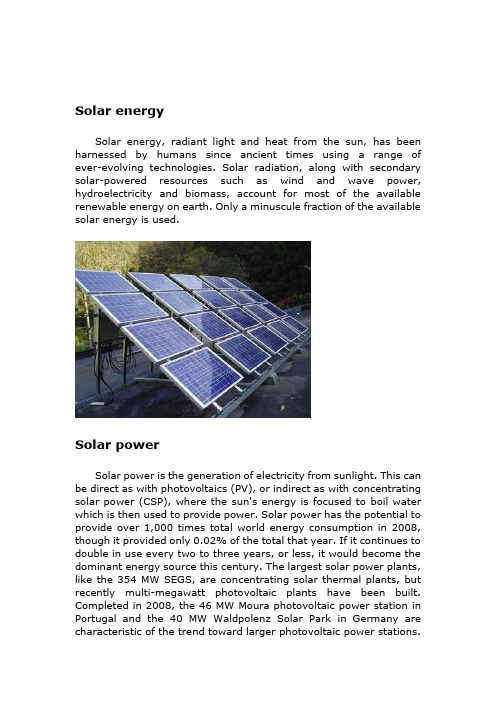
Solar energySolar energy, radiant light and heat from the sun, has been harnessed by humans since ancient times using a range of ever-evolving technologies. Solar radiation, along with secondary solar-powered resources such as wind and wave power, hydroelectricity and biomass, account for most of the available renewable energy on earth. Only a minuscule fraction of the available solar energy is used.Solar powerSolar power is the generation of electricity from sunlight. This can be direct as with photovoltaics (PV), or indirect as with concentrating solar power (CSP), where the sun's energy is focused to boil water which is then used to provide power. Solar power has the potential to provide over 1,000 times total world energy consumption in 2008, though it provided only 0.02% of the total that year. If it continues to double in use every two to three years, or less, it would become the dominant energy source this century. The largest solar power plants, like the 354 MW SEGS, are concentrating solar thermal plants, but recently multi-megawatt photovoltaic plants have been built. Completed in 2008, the 46 MW Moura photovoltaic power station in Portugal and the 40 MW Waldpolenz Solar Park in Germany are characteristic of the trend toward larger photovoltaic power stations.Much larger ones are proposed, such as the 100 MW Fort Peck Solar Farm, the 550 MW Topaz Solar Farm, and the 600 MW Rancho Cielo Solar Farm.Solar power is amazing. On average, every square meter of Earth's surface receives 164 watts of solar energy. In other words, you could stand a really powerful (150 watt) table lamp on every square meter of Earth's surface and light up the whole planet with the Sun's energy! Or, to put it another way, if we covered just one percent of the Sahara desert with solar panels, we could generate enough electricity to power the whole world. That's the good thing about solar power: there's an awful lot of it—much more than we could ever use.But there's a downside too. The energy the Sun sends out arrives on Earth as a mixture of light and heat. Both of these are incredibly important—the light makes plants grow, providing us with food, while the heat keeps us warm enough to survive—but we can't use either the Sun's light or heat directly to run a television or a car. We have to find some way of converting solar energy into other forms of energy we can use more easily, such as electricity. And that's exactly what solar panels do.Solar cellA solar cell is a device that converts the energy of sunlight directly into electricity by the photovoltaic effect. Sometimes the term solar cell is reserved for devices intended specifically to capture energy from sunlight such as solar panels and solar cells, while the term photovoltaic cell is used when the light source is unspecified. Assemblies of cells are used to make solar panels, solar modules, or photovoltaic arrays. Photovoltaics is the field of technology andresearch related to the application of solar cells in producing electricity for practical use. The energy generated this way is an example of solar energy.History of solar cellsThe development of the solar cell stems from the work of the French physicist Antoine-César Becquerel in 1839. Becquerel discovered the photovoltaic effect while experimenting with a solid electrode in an electrolyte solution; he observed that voltage developed when light fell upon the electrode. About 50 years later, Charles Fritts constructed the first true solar cells using junctions formed by coating the semiconductor selenium with an ultrathin, nearly transparent layer of gold. Fritts's devices were very inefficient, transforming less than 1 percent of the absorbed light into electrical energy.By 1927 another metalÐsemiconductor-junction solar cell, in this case made of copper and the semiconductor copper oxide, had been demonstrated. By the 1930s both the selenium cell and the copper oxide cell were being employed in light-sensitive devices, such as photometers, for use in photography. These early solar cells, however, still had energy-conversion efficiencies of less than 1 percent. This impasse was finally overcome with the development of the silicon solar cell by Russell Ohl in 1941. In 1954, three other American researchers, G.L. Pearson, Daryl Chapin, and Calvin Fuller, demonstrated a silicon solar cell capable of a 6-percent energy-conversion efficiency when used in direct sunlight. By the late 1980s silicon cells, as well as those made of gallium arsenide, with efficiencies of more than 20 percent had been fabricated. In 1989 a concentrator solar cell, a type of device in which sunlight is concentrated onto the cell surface by means of lenses, achieved an efficiency of 37 percent due to the increased intensity of the collected energy. In general, solar cells of widely varying efficiencies and cost are now available.StructureModern solar cells are based on semiconductor physics -- they are basically just P-N junction photodiodes with a very large light-sensitive area. The photovoltaic effect, which causes the cell toconvert light directly into electrical energy, occurs in the three energy-conversion layers.The first of these three layers necessary for energy conversion in a solar cell is the top junction layer (made of N-type semiconductor ). The next layer in the structure is the core of the device; this is the absorber layer (the P-N junction). The last of the energy-conversion layers is the back junction layer (made of P-type semiconductor).As may be seen in the above diagram, there are two additional layers that must be present in a solar cell. These are the electrical contact layers. There must obviously be two such layers to allow electric current to flow out of and into the cell. The electrical contact layer on the face of the cell where light enters is generally present in some grid pattern and is composed of a good conductor such as a metal. The grid pattern does not cover the entire face of the cell since grid materials, though good electrical conductors, are generally not transparent to light. Hence, the grid pattern must be widely spaced toallow light to enter the solar cell but not to the extent that the electrical contact layer will have difficulty collecting the current produced by the cell. The back electrical contact layer has no such diametrically opposed restrictions. It need simply function as an electrical contact and thus covers the entire back surface of the cell structure. Because the back layer must be a very good electrical conductor, it is always made of metal.How do solar cells workA solar cell is a sandwich of n-type silicon (blue) and p-type silicon (red).1.When sunlight shines on the cell, photons (light particles)bombard the upper surface.2.The photons (yellow blobs) carry their energy down through thecell.3.The photons give up their energy to electrons (green blobs) inthe lower, p-type layer.4.The electrons use this energy to jump across the barrier into theupper, n-type layer and escape out into the circuit.5.Flowing around the circuit, the electrons make the lamp lightup.Solar Power - Advantages and Disadvantages Solar Power AdvantagesThere are many advantages of solar energy. Just consider the advantages of solar energy over that of oil:· Solar energy is a renewable resource. Although we cannot utilize the power of the sun at night or on stormy, cloudy days, etc., we can count on the sun being there the next day, ready to give us more energy and light. As long as we have the sun, we can have solar energy (and on the day that we no longer have the sun, you can believe that we will no longer have ourselves, either).· Oil, on the other hand, is not renewable. Once it is gone, it is gone. Yes, we may find another source to tap, but that source may run out, as well.· Solar cells are totally silent. They can extract energy from the sun without making a peep. Now imagine the noise that the giant machines used to drill for and pump oil make!· Solar energy is non-polluting. Of all advantages of solar energy over that of oil, this is, perhaps, the most important. The burning of oil releases carbon dioxide and other greenhouse gases and carcinogens into the air.·Solar cells require very little maintenance (they have no moving parts that will need to be fixed), and they last a long time.· Although solar panels or solar lights, etc., may be expensive to buy at the onset, you can save money in the long run. After all, you do not have to pay for energy from the sun. On the other hand, all of us are aware of the rising cost of oil.· Solar powered lights and other solar powered products are also very easy to install. You do not even need to worry about wires.Here are the disadvantages of solar energy:•The initial cost is the main disadvantage of installing a solar energy system, largely because of the high cost of thesemi-conducting materials used in building one.•The cost of solar energy is also high compared tonon-renewable utility-supplied electricity. As energy shortages are becoming more common, solar energy is becoming moreprice-competitive.•Solar panels require quite a large area for installation to achievea good level of efficiency.•The efficiency of the system also relies on the location of the sun, although this problem can be overcome with the installation of certain components.•The production of solar energy is influenced by the presence of clouds or pollution in the air.•Similarly, no solar energy will be produced during nighttime although a battery backup system and/or net metering willsolve this problem.Development, deployment and economicsBeginning with the surge in coal use which accompanied the Industrial Revolution, energy consumption has steadily transitioned from wood and biomass to fossil fuels. The early development of solar technologies starting in the 1860s was driven by an expectation that coal would soon become scarce. However development of solar technologies stagnated in the early 20th century in the face of the increasing availability, economy, and utility of coal and petroleum.The 1973 oil embargo and 1979 energy crisis caused a reorganization of energy policies around the world and brought renewed attention to developing solar technologies.Deployment strategies focused on incentive programs such as the Federal Photovoltaic Utilization Program in the US and the Sunshine Program in Japan. Other efforts included the formation of research facilities in the US (SERI, now NREL), Japan (NEDO), and Germany (Fraunhofer Institute for Solar Energy Systems ISE).Between 1970 and 1983 photovoltaic installations grew rapidly, but falling oil prices in the early 1980s moderated the growth of PV from 1984 to 1996.Photovoltaic production growth has averaged 40% per year since 2000 and installed capacity reached 10.6 GW at the end of 2007,and 14.73 GW in 2008.Since 2006 it has beeneconomical for investors to install photovoltaics for free in return for a long term power purchase agreement. 50% of commercial systems were installed in this manner in 2007 and it is expected that 90% will by 2009. Nellis Air Force Base is receiving photoelectric power for about 2.2 ¢/kWh and grid power for 9 ¢/kWh.Commercial concentrating solar thermal power (CSP) plants were first developed in the 1980s. CSP plants such as SEGS project in the United States have a levelized energy cost (LEC) of 12–14 ¢/kWh.The 11 MW PS10 power tower in Spain, completed in late 2005, is Europe's first commercial CSP system, and a total capacity of 300 MW is expected to be installed in the same area by 2013.In August 2009, First Solar announced plans to build a 2 GW photovoltaic system in Ordos City, Inner Mongolia, China in four phases consisting of 30 MW in 2010, 970 MW in 2014, and another 1000 MW by 2019. As of June 9, 2009, there is a new solar thermal power station being built in the Banaskantha district in North Gujarat. Once completed, it will be the world's largest.。
新能源方面的英语
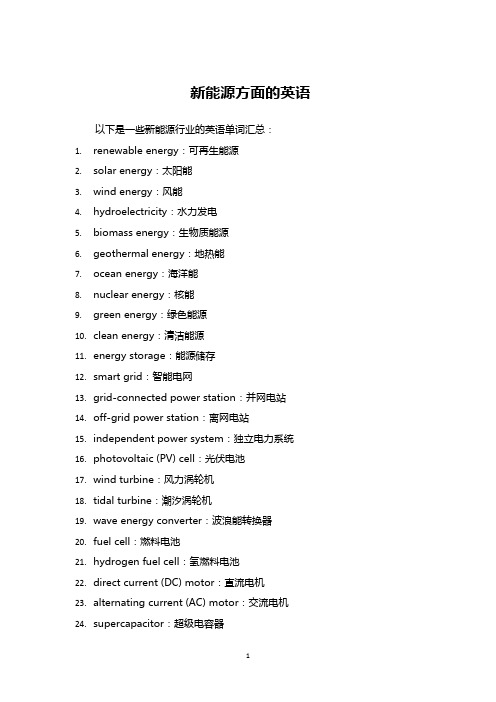
新能源方面的英语以下是一些新能源行业的英语单词汇总:1.renewable energy:可再生能源2.solar energy:太阳能3.wind energy:风能4.hydroelectricity:水力发电5.biomass energy:生物质能源6.geothermal energy:地热能7.ocean energy:海洋能8.nuclear energy:核能9.green energy:绿色能源10.clean energy:清洁能源11.energy storage:能源储存12.smart grid:智能电网13.grid-connected power station:并网电站14.off-grid power station:离网电站15.independent power system:独立电力系统16.photovoltaic (PV) cell:光伏电池17.wind turbine:风力涡轮机18.tidal turbine:潮汐涡轮机19.wave energy converter:波浪能转换器20.fuel cell:燃料电池21.hydrogen fuel cell:氢燃料电池22.direct current (DC) motor:直流电机23.alternating current (AC) motor:交流电机24.supercapacitor:超级电容器25.lithium-ion battery:锂离子电池26.lead-acid battery:铅酸电池27.nanomaterials:纳米材料28.smart meter:智能电表29.efficiency:效率30.conversion efficiency:转换效率。
介绍太阳能的英文文章
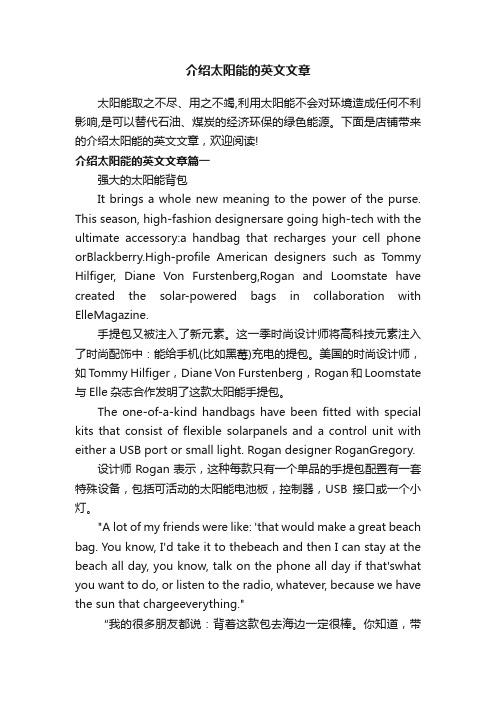
介绍太阳能的英文文章太阳能取之不尽、用之不竭,利用太阳能不会对环境造成任何不利影响,是可以替代石油、煤炭的经济环保的绿色能源。
下面是店铺带来的介绍太阳能的英文文章,欢迎阅读!介绍太阳能的英文文章篇一强大的太阳能背包It brings a whole new meaning to the power of the purse. This season, high-fashion designersare going high-tech with the ultimate accessory:a handbag that recharges your cell phone orBlackberry.High-profile American designers such as Tommy Hilfiger, Diane Von Furstenberg,Rogan and Loomstate have created the solar-powered bags in collaboration with ElleMagazine.手提包又被注入了新元素。
这一季时尚设计师将高科技元素注入了时尚配饰中:能给手机(比如黑莓)充电的提包。
美国的时尚设计师,如Tommy Hilfiger,Diane Von Furstenberg,Rogan和Loomstate 与Elle杂志合作发明了这款太阳能手提包。
The one-of-a-kind handbags have been fitted with special kits that consist of flexible solarpanels and a control unit with either a USB port or small light. Rogan designer RoganGregory.设计师Rogan表示,这种每款只有一个单品的手提包配置有一套特殊设备,包括可活动的太阳能电池板,控制器,USB接口或一个小灯。
solar energy(英语简介)
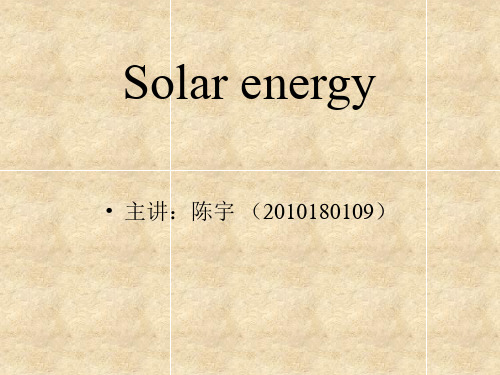
• Theoretically speaking, the solar battery conversion efficiency can almost 100%. However, due to current this research is still in the cradle. • Solution of solar cell formation in very low concentrations, its conversion efficiency is very low ,also along with the further perfecting experiment, conversion efficiency will keep growing.
But there are many limitations of using solar energy
• (1) dispersion (low energy density) • (2) Instability • (3) Low efficiency and high cost.
太阳能
How can we make full use of solar energy?
太阳能专业英语翻译
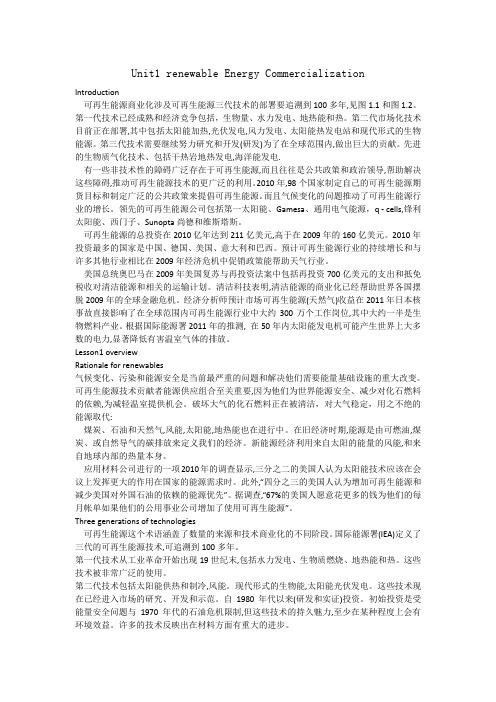
Unit1 renewable Energy CommercializationIntroduction可再生能源商业化涉及可再生能源三代技术的部署要追溯到100多年,见图1.1和图1.2。
第一代技术已经成熟和经济竞争包括,生物量、水力发电、地热能和热。
第二代市场化技术目前正在部署,其中包括太阳能加热,光伏发电,风力发电、太阳能热发电站和现代形式的生物能源。
第三代技术需要继续努力研究和开发(研发)为了在全球范围内,做出巨大的贡献。
先进的生物质气化技术、包括干热岩地热发电,海洋能发电.有一些非技术性的障碍广泛存在于可再生能源,而且往往是公共政策和政治领导,帮助解决这些障碍,推动可再生能源技术的更广泛的利用。
2010年,98个国家制定自己的可再生能源期货目标和制定广泛的公共政策来提倡可再生能源。
而且气候变化的问题推动了可再生能源行业的增长。
领先的可再生能源公司包括第一太阳能、Gamesa、通用电气能源,q - cells,锋利太阳能、西门子、Sunopta尚德和维斯塔斯。
可再生能源的总投资在2010亿年达到211亿美元,高于在2009年的160亿美元。
2010年投资最多的国家是中国、德国、美国、意大利和巴西。
预计可再生能源行业的持续增长和与许多其他行业相比在2009年经济危机中促销政策能帮助天气行业。
美国总统奥巴马在2009年美国复苏与再投资法案中包括再投资700亿美元的支出和抵免税收对清洁能源和相关的运输计划。
清洁科技表明,清洁能源的商业化已经帮助世界各国摆脱2009年的全球金融危机。
经济分析师预计市场可再生能源(天然气)收益在2011年日本核事故直接影响了在全球范围内可再生能源行业中大约300万个工作岗位,其中大约一半是生物燃料产业。
根据国际能源署2011年的推测, 在50年内太阳能发电机可能产生世界上大多数的电力,显著降低有害温室气体的排放。
Lesson1 overviewRationale for renewables气候变化、污染和能源安全是当前最严重的问题和解决他们需要能量基础设施的重大改变。
clean energy 所有清洁能源的英文表达
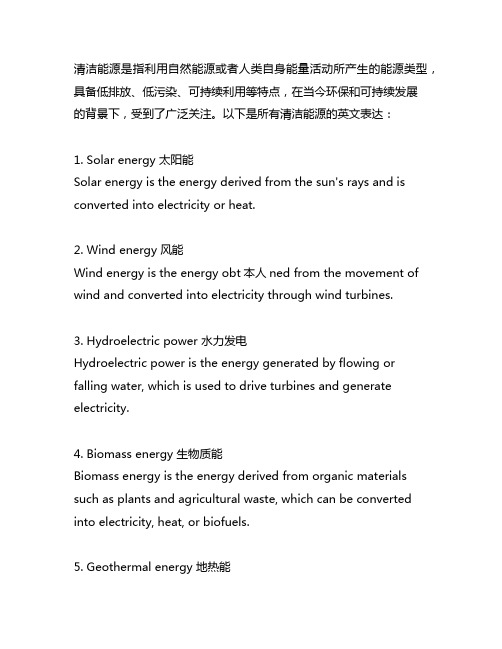
清洁能源是指利用自然能源或者人类自身能量活动所产生的能源类型,具备低排放、低污染、可持续利用等特点,在当今环保和可持续发展的背景下,受到了广泛关注。
以下是所有清洁能源的英文表达:1. Solar energy 太阳能Solar energy is the energy derived from the sun's rays and is converted into electricity or heat.2. Wind energy 风能Wind energy is the energy obt本人ned from the movement of wind and converted into electricity through wind turbines.3. Hydroelectric power 水力发电Hydroelectric power is the energy generated by flowing or falling water, which is used to drive turbines and generate electricity.4. Biomass energy 生物质能Biomass energy is the energy derived from organic materials such as plants and agricultural waste, which can be converted into electricity, heat, or biofuels.5. Geothermal energy 地热能Geothermal energy is the energy obt本人ned from the heat within the Earth's crust, which can be used for heating or electricity generation.6. Tidal energy 潮汐能Tidal energy is the energy derived from the movement of tides, which can be harnessed to generate electricity.7. Wave energy 海浪能Wave energy is the energy obt本人ned from the movement of ocean waves, which can be converted into electricity.8. Nuclear energy 核能Nuclear energy is the energy released from nuclear reactions, which can be used to generate electricity.以上是所有清洁能源的英文表达,这些清洁能源的应用可以有效减少对传统化石能源的依赖,降低环境污染,保护自然资源,推动全球可持续发展。
新能源 英文简介范文

新能源英文简介范文New Energy: The Future of Sustainable Development.As the world faces increasing challenges related to climate change and environmental degradation, the need for renewable and sustainable energy sources has become paramount. New energy, also known as renewable energy, refers to a range of resources that are continuously replenished by natural processes and have the potential to meet the world's energy needs without causing harmful emissions or exhausting natural resources.Types of New Energy.1. Solar Energy: Solar energy harnesses the power of the sun's radiation. Photovoltaic cells convert sunlight into electricity, while solar thermal systems capture the sun's heat for use in heating, cooling, and other applications.2. Wind Energy: Wind turbines convert the kinetic energy of the wind into electricity. With advances in turbine design and materials, wind energy has become acost-effective and reliable source of renewable power.3. Hydroelectric Energy: This form of energy harnesses the kinetic energy of moving water, either from rivers or dams, to generate electricity. Hydroelectric power plants are a long-standing renewable energy source, but their construction can have significant environmental impacts.4. Biomass Energy: Biomass refers to organic matter derived from plants or animals that can be converted into energy. This can include wood, agricultural waste, and even waste from industries. Biomass energy can be used for heating, electricity generation, and biofuels.5. Geothermal Energy: Geothermal energy taps into the heat stored within the Earth's crust. This heat can be used for heating, cooling, and electricity generation, often in the form of geothermal power plants.Advantages of New Energy.Environmental Benefits: Renewable energy sources emit far less greenhouse gases and air pollution than fossil fuels, helping to mitigate the impacts of climate change.Sustainability: New energy sources are renewable, meaning they can be replenished over time, ensuring a sustainable energy supply for future generations.Energy Security: Diversifying energy sources and reducing reliance on fossil fuels improves energy security, reducing the risk of supply interruptions and price fluctuations.Economic Growth: Investing in renewable energy creates jobs, stimulates innovation, and drives economic growth.Challenges and Solutions.Despite the many advantages of new energy, there are also challenges that need to be addressed.Intermittency: Sources like solar and wind energy are intermittent, meaning their availability can vary depending on weather conditions. To address this, energy storage systems and smart grids are being developed to balance supply and demand.Infrastructure: Building out renewable energy infrastructure requires significant investment and can be challenging in rural or remote areas. Public-private partnerships and innovative financing mechanisms can help overcome these barriers.Policy and Regulations: Favorable policies and regulations that promote renewable energy deployment and encourage innovation are crucial for its widespread adoption.Conclusion.In conclusion, new energy represents a crucial step towards a sustainable and environmentally friendly energyfuture. By harnessing the power of renewable resources like solar, wind, and geothermal energy, we can meet our energy needs while protecting the planet for future generations. While challenges remain, ongoing research, innovation, and policy reform can help us overcome these obstacles and move towards a cleaner, safer energy future.。
环保资源—太阳能英文翻译Environmental resources - solar energy

环保资源—太阳能随着城市人口的增加,城市面积的不断扩大,红绿灯安装在各个道口上,已经成为疏导交通车辆最常见和最有效的手段。
但这一技术在19世纪就已出现了。
1858年,在英国伦敦主要街头安装了以燃煤气为光源的红,蓝两色的机械扳手式信号灯,用以指挥马车通行。
这是世界上最早的交通信号灯。
1868年,英国机械工程师纳伊特在伦敦威斯敏斯特区的议会大厦前的广场上,安装了世界上最早的煤气红绿灯。
它由红绿两以旋转式方形玻璃提灯组成,红色表示“停止”,绿色表示“注意”。
1869年1月2日,煤气灯爆炸,使警察受伤,遂被取消。
1914年,电气启动的红绿灯出现在美国。
这种红绿灯由红绿黄三色圆形的投光器组成,安装在纽约市5号大街的一座高塔上。
红灯亮表示“停止”,绿灯亮表示“通行”。
1918年,又出现了带控制的红绿灯和红外线红绿灯。
带控制的红绿灯,一种是把压力探测器安在地下,车辆一接近红灯便变为绿灯;另一种是用扩音器来启动红绿灯,司机遇红灯时按一下嗽叭,就使红灯变为绿灯。
红外线红绿灯当行人踏上对压力敏感的路面时,它就能察觉到有人要过马路。
红外光束能把信号灯的红灯延长一段时间,推迟汽车放行,以免发生交通事故。
总之,信号灯的出现,使交通得以有效管制,对于疏导交通流量、提高道路通行能力,减少交通事故有明显效果。
但是,目前随着世界各国石油、煤炭等自然资源的匮乏,全国大部分地区为了对付缺电,实行了分地区分时段的拉闸限电措施,而交通灯作为重要的指挥工具也由于市电的断电而不能工作,造成了交通安全隐患。
随着全球能源危机和环境恶化,太阳能以其无污染、无噪声、拆装移动简易、不会破坏市容环境、不受地理位置限制等特有的优势,将代替传统的不可再生能源,成为人类社会取之不尽、用之不竭的低成本环保清洁能源,太阳能发电将走入普通老百姓的日常生活,节约电费和能源,保护环境,造福人类。
因此,利用太阳能对交通灯进行供电,通过带有蓄电池的太阳能电池板跟普通交通灯相连,来实现利用太阳能给交通灯供电,不仅能够节约资源,而且使其在市电断电情况下也能正常工作。
英语PPT:太阳能

• 太阳能发电 Water and Wind • 水力、风力发电Power Generation
• 地热发电 • 生物质能发电
Geothermal Power Generation
Biomass Energy Generation
Listen & Learn
Translate and Read
5. 生物质能是一种由生物质产生的能量。
The bioenergy is a kind of energy that is generated by biomass. 6. 生物质能是可再生的。 The bioenergy is renewable.
Types of the Generation by Green Energy Sources
A.无枯竭危险 B. 绝对干净 C.使用不受限制 D.能源质量高 E.使用者容易接受 F.节省时间
As early as 1980, NASA and the Department of Energy have a proposed ideas ,that's to building a solar power stations in space,
• 在用电处就近发电
英文版
Disadvantages (1) The density of radiation is small, but take up a huge area (2) Getting energy is related to the weather (3) Instabilities (4) Low efficient and high cost
早在1980年美国宇 航局和能源部就提 出在空间建设太阳 能发电站设想,
清洁能源太阳能与电动汽车英语作文

Solar Energy and Electric Vehicles: TheFuture of Sustainable TransportationIn the face of the looming energy crisis and the urgent need for environmental protection, the combination of solar energy and electric vehicles has emerged as a promising solution for sustainable transportation. Solar energy, a renewable and pollution-free resource, offers a sustainable alternative to fossil fuels, while electric vehicles (EVs) provide a clean and efficient mode of transportation.Solar energy has the potential to meet a significant portion of the world's energy demands. With the advancements in solar technology, photovoltaic (PV) panels have become more efficient and cost-effective, making them a viable option for both residential and commercial use. Solar panels can be installed on rooftops, deserts, and even floating on water bodies, harnessing the vast amount of solar radiation that reaches the Earth's surface.Electric vehicles, on the other hand, offer a clean and silent mode of transportation. Unlike traditional gasoline-powered vehicles, EVs do not emit harmful greenhouse gases or air pollutants, significantly reducing the environmentalimpact of transportation. With the development of battery technology, EVs now have a longer range and faster charging times, making them more convenient and practical for daily use.The combination of solar energy and EVs creates a virtuous cycle. Solar panels can be installed at charging stations or even integrated into the design of EVs, allowing them to be charged directly from solar power. This not only reduces the carbon footprint of transportation but also reduces the demand for fossil fuels, further promoting the adoption of renewable energy.Moreover, the integration of solar energy and EVs creates new business opportunities and jobs. The manufacturing, installation, and maintenance of solar panels and EVs require skilled workers, driving economic growth and creating sustainable employment. Additionally, the widespread adoption of EVs will lead to the development of a robust charging infrastructure, further stimulating economic activity.In conclusion, the integration of solar energy and electric vehicles holds the key to sustainabletransportation. By harnessing the power of the sun and adopting clean modes of transportation, we can reduce our carbon footprint, protect the environment, and create a better future for ourselves and our planet.**太阳能与电动汽车:可持续交通的未来**面对能源危机和环境保护的紧迫需求,太阳能与电动汽车的结合已成为可持续交通的一种有前途的解决方案。
Solar Energy太阳能英语作文
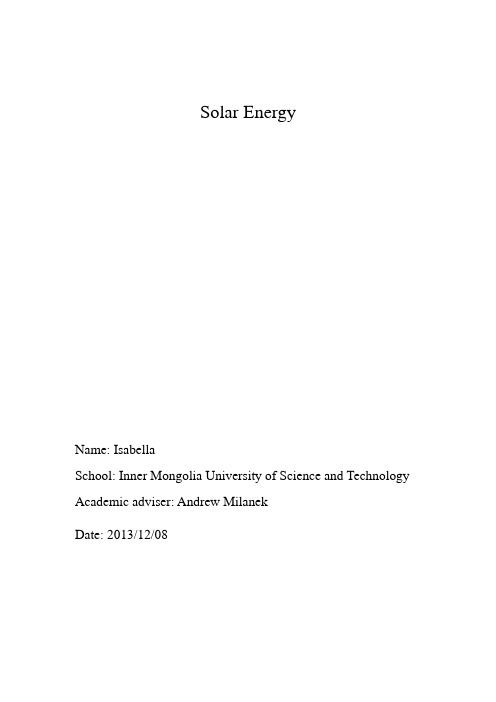
Solar EnergyName: IsabellaSchool: Inner Mongolia University of Science and Technology Academic adviser: Andrew MilanekDate: 2013/12/08Imagine a world where sunlight can be captured to produce electricity anywhere, on any surface. The makers of thin-film flexible solar cells imagine that world too. But a big problem has been the amount of silicon needed to harvest a little sunshine.Now, researchers at Caltech say they’ve designed a device that gets comparable solar absorption while using just one percent of the silicon per unit area that current solar cells need. The work was published in the journal Nature Materials.In recent years, the solar energy for the benefit of mankind's technology industry has become more and more developed.Human has a long history to use the solar energy. “China as early as two thousand years ago, during the Warring States period, know the use of four steel mirror to focus sunlight ignition; use of solar energy to dry agricultural products.”The development of modern, solar energy has become increasingly widespread use, which includes the use of solar energy solar thermal, solar photovoltaic.What’s more solar energy was used by photochemical and so on.People use the solar energy in two ways: the photothermal conversion and the photoelectric conversion.At present, many scientists hold optimistic attitude on the prospect of the solar energy .There are three reasons:(1)General: the sun shines on the earth, whether land or sea, regardless of the mountains or islands, are found everywhere, direct the development and utilization, and exploitation and transportation needless. (2) Sound: the development and utilization of solar energy will not pollute the environment, it is one of the most clean energy。
太阳能的利用和发展英语作文
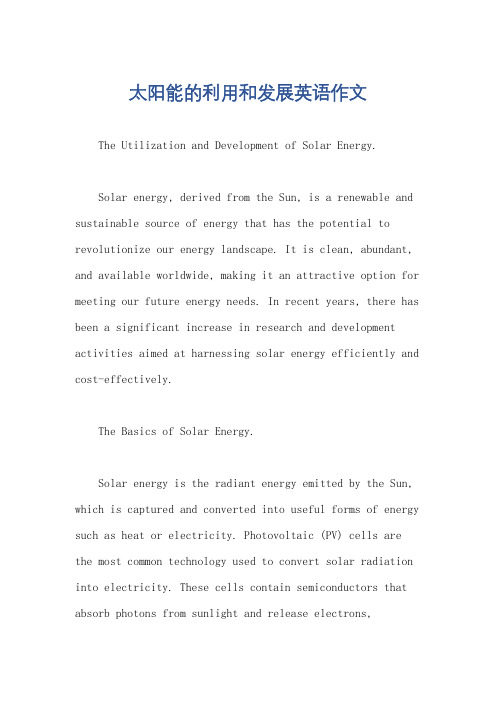
太阳能的利用和发展英语作文The Utilization and Development of Solar Energy.Solar energy, derived from the Sun, is a renewable and sustainable source of energy that has the potential to revolutionize our energy landscape. It is clean, abundant, and available worldwide, making it an attractive option for meeting our future energy needs. In recent years, there has been a significant increase in research and development activities aimed at harnessing solar energy efficiently and cost-effectively.The Basics of Solar Energy.Solar energy is the radiant energy emitted by the Sun, which is captured and converted into useful forms of energy such as heat or electricity. Photovoltaic (PV) cells are the most common technology used to convert solar radiation into electricity. These cells contain semiconductors that absorb photons from sunlight and release electrons,generating a flow of electric current.Advantages of Solar Energy.Solar energy offers several advantages over traditional energy sources. Firstly, it is a renewable resource thatwill not change for billions of years, ensuring a sustainable supply of energy. Secondly, solar energy is clean and does not produce harmful emissions or pollutants, thus contributing to a reduction in air and water pollution. Furthermore, solar energy can be harnessed in remote areas where access to other forms of energy may be limited.Challenges and Limitations.Despite its many advantages, solar energy also faces some challenges and limitations. One of the primary challenges is the intermittency of solar radiation, which depends on weather conditions and the time of day. Cloud cover, dust, and shadows can significantly reduce the amount of solar radiation reaching photovoltaic cells. Additionally, the high upfront costs of solar energysystems can be a barrier to their widespread adoption.Innovations and Developments.To overcome these challenges, significant research and development efforts are being made in the field of solar energy. One such innovation is the development of more efficient photovoltaic cells. Scientists are constantly exploring new materials and technologies that can improve the conversion efficiency of solar cells, making them more cost-effective and viable for widespread use.Another important development is the integration ofsolar energy into smart grids and distributed generation systems. These systems allow solar energy to be integrated seamlessly into the existing power grid, providingstability and reliability to the power supply. Additionally, they enable individuals and communities to generate and consume their own solar energy, reducing their dependencyon centralized power plants.Future Prospects.The future of solar energy looks promising. With advancements in technology and decreasing costs, solar energy is becoming increasingly competitive withtraditional energy sources. Governments and private sector organizations are investing heavily in solar energy projects, and the industry is expected to continue to grow in the coming years.Solar energy has the potential to play a pivotal role in addressing climate change and achieving sustainable development goals. By harnessing the power of the Sun, we can reduce our carbon footprint, enhance energy security, and create new economic opportunities in the renewable energy sector.In conclusion, solar energy represents a viable and sustainable solution for meeting our future energy needs. With continued research, innovation, and investment, solar energy has the potential to transform our energy landscape and contribute to a cleaner, greener, and more sustainable world.。
以新能源为题的英语作文
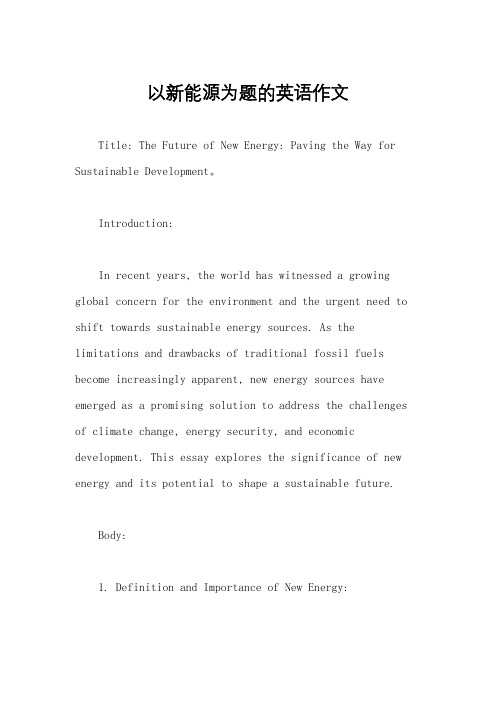
以新能源为题的英语作文Title: The Future of New Energy: Paving the Way for Sustainable Development。
Introduction:In recent years, the world has witnessed a growing global concern for the environment and the urgent need to shift towards sustainable energy sources. As the limitations and drawbacks of traditional fossil fuels become increasingly apparent, new energy sources have emerged as a promising solution to address the challenges of climate change, energy security, and economic development. This essay explores the significance of new energy and its potential to shape a sustainable future.Body:1. Definition and Importance of New Energy:New energy, also known as renewable or clean energy, refers to energy sources that are naturally replenished and have a minimal impact on the environment. These sources include solar, wind, hydro, geothermal, and biomass energy. The importance of new energy lies in its ability to reduce greenhouse gas emissions, diversify energy supplies, and promote sustainable development.2. Solar Energy:Solar energy harnesses the power of the sun to generate electricity and heat. It is one of the most abundant and widely available energy sources. Solar panels convert sunlight into electricity through the photovoltaic effect. The adoption of solar energy has seen remarkable growth in recent years, with falling costs and technological advancements making it increasingly accessible. Solar energy not only reduces carbon emissions but also provides opportunities for decentralized power generation and energy independence.3. Wind Energy:Wind energy utilizes the kinetic energy of the wind to generate electricity. Wind turbines, often seen in wind farms, capture the wind's energy and convert it into electrical power. Wind energy is a clean and abundant resource that is capable of supplying a significant portion of the world's electricity demand. However, itsintermittent nature and the need for suitable windconditions pose challenges that require advanced grid integration and energy storage solutions.4. Hydro Energy:Hydro energy, derived from the gravitational force of flowing or falling water, has been harnessed for centuries. Hydroelectric power plants convert the energy of moving water into electricity. Large-scale hydroelectric projects, such as dams, have the potential to provide a stable and reliable source of clean energy. However, concerns overtheir environmental impact, including habitat disruptionand greenhouse gas emissions from reservoirs, have led tothe exploration of smaller-scale, low-impact hydro projects.5. Geothermal Energy:Geothermal energy utilizes the heat stored within the Earth's crust to generate electricity and heat. Geothermal power plants extract steam or hot water from underground reservoirs to drive turbines and produce electricity. This form of energy is highly reliable and can provide baseload power, contributing to grid stability. While geothermal resources are limited to specific regions, advancements in technology have opened up opportunities for enhanced geothermal systems (EGS) that can tap into deeper, hotter reservoirs.6. Biomass Energy:Biomass energy is derived from organic materials, such as wood, agricultural residues, and dedicated energy crops. It can be converted into heat, electricity, or biofuels through processes like combustion, gasification, or fermentation. Biomass energy offers a sustainable alternative to fossil fuels and can contribute to wastemanagement and rural development. However, careful management is required to ensure that biomass production does not compete with food production or cause deforestation.7. Challenges and Opportunities:While new energy sources hold immense potential, several challenges must be addressed for their widespread adoption. These challenges include high initial costs, intermittency, grid integration, energy storage, and public acceptance. However, ongoing research, technological advancements, and supportive policies are paving the wayfor overcoming these obstacles. Additionally, thetransition to new energy sources presents significant economic opportunities, including job creation, technological innovation, and energy independence.Conclusion:New energy sources offer a transformative solution to combat climate change, enhance energy security, and fostersustainable development. Solar, wind, hydro, geothermal, and biomass energy have the potential to replacetraditional fossil fuels and pave the way for a cleaner and more sustainable future. Governments, businesses, and individuals must work together to accelerate the transition towards new energy sources by investing in research and development, implementing supportive policies, and embracing renewable energy technologies. By doing so, we can ensure a brighter and greener future for generations to come.。
未来太阳能英语作文初一
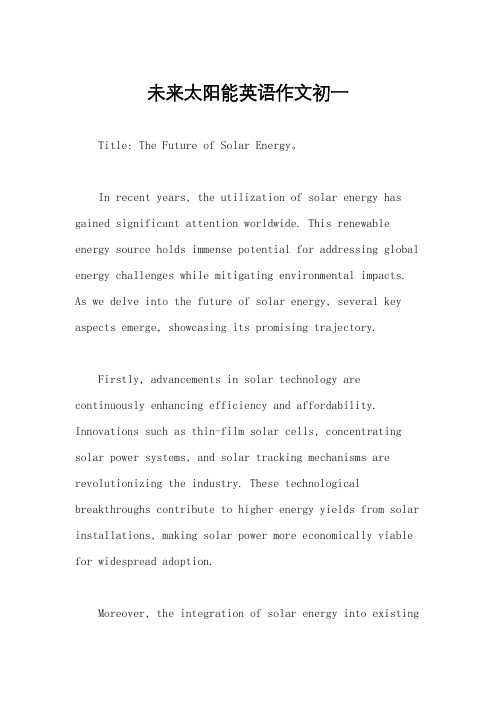
未来太阳能英语作文初一Title: The Future of Solar Energy。
In recent years, the utilization of solar energy has gained significant attention worldwide. This renewable energy source holds immense potential for addressing global energy challenges while mitigating environmental impacts. As we delve into the future of solar energy, several key aspects emerge, showcasing its promising trajectory.Firstly, advancements in solar technology are continuously enhancing efficiency and affordability. Innovations such as thin-film solar cells, concentrating solar power systems, and solar tracking mechanisms are revolutionizing the industry. These technological breakthroughs contribute to higher energy yields from solar installations, making solar power more economically viable for widespread adoption.Moreover, the integration of solar energy into existinginfrastructure and urban landscapes is becomingincreasingly seamless. Building-integrated photovoltaics (BIPV) allow solar panels to be incorporated directly into building materials like roofs and facades, maximizingenergy generation without compromising aesthetics. Additionally, solar-powered street lights, parking meters, and other urban amenities demonstrate the versatility and practicality of solar energy in urban environments.Furthermore, the scalability of solar power makes it adaptable to various scales of energy needs, from small-scale residential installations to large-scale utilitysolar farms. This flexibility enables communities and regions to tailor their energy solutions according to their specific requirements and resources. Off-grid solar systems, in particular, offer energy access to remote and underserved areas, empowering communities and fostering socio-economic development.In terms of environmental sustainability, solar energy presents a compelling solution to reducing greenhouse gas emissions and combating climate change. Unlike fossil fuels,solar power generation produces minimal to no air or water pollution, mitigating environmental degradation and public health risks associated with conventional energy sources. By transitioning to solar energy, societies cansignificantly reduce their carbon footprint and contribute to a cleaner, more sustainable future.Additionally, the decentralization of energy production through solar power decentralizes power generation, reducing reliance on centralized grid systems and enhancing energy resilience. Distributed solar energy systems, coupled with energy storage technologies like batteries, offer reliable power supply during grid outages and emergencies, bolstering energy security and grid stability.Looking ahead, policy support and investment in solar energy infrastructure are crucial for accelerating its widespread adoption and maximizing its potential benefits. Governments, businesses, and international organizations must collaborate to implement favorable policies, incentives, and financing mechanisms that promote solar energy deployment and research. By fostering an enablingenvironment for solar innovation and investment, we can expedite the transition towards a sustainable energy future.In conclusion, the future of solar energy appears bright, characterized by technological advancements, increased integration, scalability, environmental sustainability, and energy resilience. Embracing solarpower as a primary energy source holds the key toaddressing global energy challenges, combating climate change, and fostering inclusive socio-economic development. Through concerted efforts and strategic investments, we can unlock the full potential of solar energy and pave the way towards a cleaner, greener, and more prosperous tomorrow.。
英语太阳能
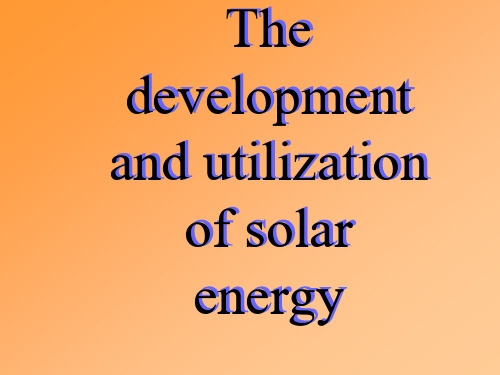
S太ec阳on能d: no matter where we can use solar energy in the earth, there is no transport problems, particularly in rural areas with poor communications, islands and remote areas, more use of value.
太阳能
Third: Solar energy is a clean source of energy. In the development and utilization, it will not generate waste, wastewater, waste gas, no noise, but will not affect the ecological balance. Will not cause pollution.
as a new energy, solar energy has three characteristics compared to conventional energy sources: first: it is human beings can use the most abundant source of energy, enough to supply the earth for future human use of billions of years.
• In the solar energy industry the development of conversion technology using solar water heaters is undoubtedly the most mature, and its industrialization process is advanced than solar power and other industries
太阳能的英语作文

太阳能的英语作文Title: Solar Energy。
Solar energy, also known as solar power, is the energy that is derived from the sun's radiation. This form of energy is harnessed using technology such as solar panels, which are designed to capture and convert sunlight into electricity. Solar energy is a renewable and sustainable source of power, and it has the potential to revolutionize the way we generate electricity and power our homes, businesses, and communities.One of the key advantages of solar energy is its abundance. The sun is an incredibly powerful and consistent source of energy, providing an almost unlimited supply of sunlight each day. This means that solar energy has the potential to meet a significant portion of our energy needs, reducing our reliance on non-renewable sources such as coal, oil, and natural gas. In addition, solar energy is cleanand environmentally friendly, producing no harmfulemissions or pollutants. This makes it an attractive option for combating climate change and reducing air and water pollution.Another benefit of solar energy is its versatility. Solar panels can be installed on a wide range of surfaces, including rooftops, open fields, and even on water. This flexibility allows solar energy to be integrated into a variety of settings, from urban areas to remote locations. In addition, solar energy can be used to power a wide range of applications, from small-scale residential systems to large-scale commercial and industrial installations. This versatility makes solar energy a practical and adaptable solution for meeting a diverse set of energy needs.Furthermore, solar energy offers economic benefits. As the technology for capturing and converting solar energy continues to advance, the cost of solar panels and related equipment has decreased significantly. This has made solar energy more accessible and affordable for individuals, businesses, and governments. In many cases, investing in solar energy can lead to long-term cost savings, as theenergy generated from solar panels can offset or even eliminate the need to purchase electricity from the grid. This can result in lower energy bills and a reducedreliance on fossil fuels, providing both financial and environmental benefits.In addition to its practical and economic advantages, solar energy also has the potential to create jobs and stimulate economic growth. The solar energy industry encompasses a wide range of professions, including engineers, technicians, installers, and sales and marketing professionals. As the demand for solar energy continues to grow, so too does the need for skilled workers to design, install, and maintain solar energy systems. This can leadto job creation and economic development in communitiesthat embrace solar energy as part of their energy portfolio.While solar energy offers numerous benefits, there are also challenges and limitations to consider. For example,the efficiency of solar panels can be affected by factors such as weather, location, and shading. In addition, the initial investment required to install solar panels may bea barrier for some individuals and businesses, despite the long-term cost savings. Furthermore, the storage and distribution of solar energy can present technical and logistical challenges, particularly in areas with limited infrastructure or grid connectivity. However, ongoing research and development in the field of solar energy continue to address these challenges, leading to improvements in efficiency, affordability, and reliability.In conclusion, solar energy has the potential to play a significant role in our transition to a more sustainable and environmentally friendly energy system. With its abundance, versatility, economic benefits, and potentialfor job creation, solar energy offers a compelling solution to our energy needs. As technology continues to advance and the cost of solar energy continues to decrease, we can expect to see an increasing adoption of solar power across the globe. By harnessing the power of the sun, we can reduce our reliance on fossil fuels, mitigate climate change, and create a cleaner and brighter future for generations to come.。
关于太阳能英文作文5篇
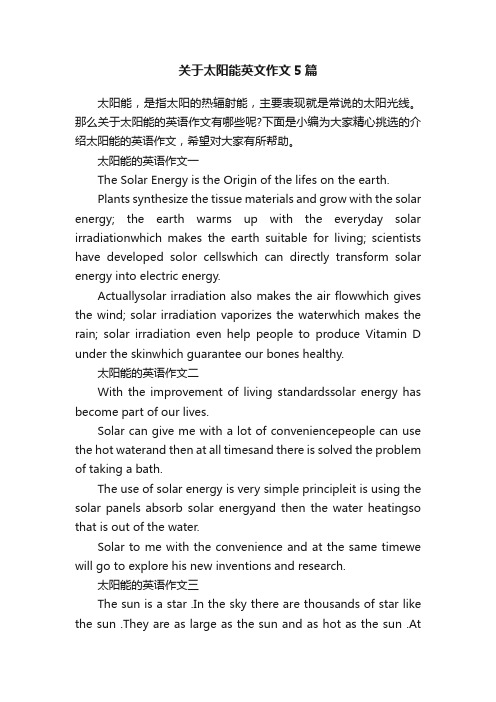
关于太阳能英文作文5篇太阳能,是指太阳的热辐射能,主要表现就是常说的太阳光线。
那么关于太阳能的英语作文有哪些呢?下面是小编为大家精心挑选的介绍太阳能的英语作文,希望对大家有所帮助。
太阳能的英语作文一The Solar Energy is the Origin of the lifes on the earth.Plants synthesize the tissue materials and grow with the solar energy; the earth warms up with the everyday solar irradiationwhich makes the earth suitable for living; scientists have developed solor cellswhich can directly transform solar energy into electric energy.Actuallysolar irradiation also makes the air flowwhich gives the wind; solar irradiation vaporizes the waterwhich makes the rain; solar irradiation even help people to produce Vitamin D under the skinwhich guarantee our bones healthy.太阳能的英语作文二With the improvement of living standardssolar energy has become part of our lives.Solar can give me with a lot of conveniencepeople can use the hot waterand then at all timesand there is solved the problem of taking a bath.The use of solar energy is very simple principleit is using the solar panels absorb solar energyand then the water heatingso that is out of the water.Solar to me with the convenience and at the same timewe will go to explore his new inventions and research.太阳能的英语作文三The sun is a star .In the sky there are thousands of star like the sun .They are as large as the sun and as hot as the sun .Atnight you can see many stars, but in day-time you can only see one star ---the sun.The sun is much nearer to us than any other star.That is why it books like the biggest and brightest of all the stars .The distance of the sun from the Earth is as much as 150 million kilometres .Most of the stars are thousands of light years away from the Earth .Do you know what a light year is ?Nothing in the world travels faster than light .It travels 300,000 kilometers a second .One light year is the distance that light travels in one year .太阳能的英语作文四An Earthship is a type of passive solar home made of natural and recycled materials. Designed and marketed by Earthship Biotecture of Taos, New Mexico, the homes are primarily constructed to work autonomously and are generally made of earth-filled tires, utilising thermal mass construction to naturally regulate indoor temperature. They also usually have their own special natural ventilation system. Earthships are generally Off-the-grid homes, minimizing their reliance on public utilities and fossil fuels. fROM .Earthships are built to utilize the available local resources, especially energy from the sun. For example, windows on the sunny side admit light and heat, and the buildings are often horseshoe-shaped to maximize natural light and solar-gain during winter months. Likewise, the thick, dense outer walls provide effective insulation against summer heat.Internal, non-load-bearing walls are often made of a honeycomb of recycled cans joined by concrete and are referred to as tin can walls. These walls are usually thickly plastered withstucco.The roof of an Earthship is heavily insulated - often with earth or adobe - for added energy efficiency.太阳能的英语作文五Solar cars combine technology typically used in the aerospace bicycle alternative energy and automotive industries.The design of a solar vehicle is severely limited by the amount of energy input into the car. Most solar cars have been built for the purpose of solar car races.Exceptions include solar-powered cars and utility vehicles.Solar cars are often fitted with gauges as seen in conventional cars. In order to keep the car running smoothly the driver must keep an eye on these gauges to spot possible problems.Cars without gauges almost always feature wireless telemetry which allows the driver's team to monitor the car's energy consumption solar energy capture and other parameters and free the driver to concentrate on driving.Solar cars depend on PV cells to convert sunlight into electricity. In fact 51% of sunlight actually enters the Earth's atmosphere.Unlike solar thermal energy which converts solar energy to heat for either household purposes industrial purposes or to be converted to electricity PV cells directly convert sunlight into electricity.When sunlight (photons) strike PV cells they excite electrons and allow them to flow creating an electrical current.PV cells are made of semiconductor materials such as silicon and alloys of indium gallium and nitrogen. Silicon is the most common material used and has an efficiency rate of 15-20%.。
太阳能的的英语
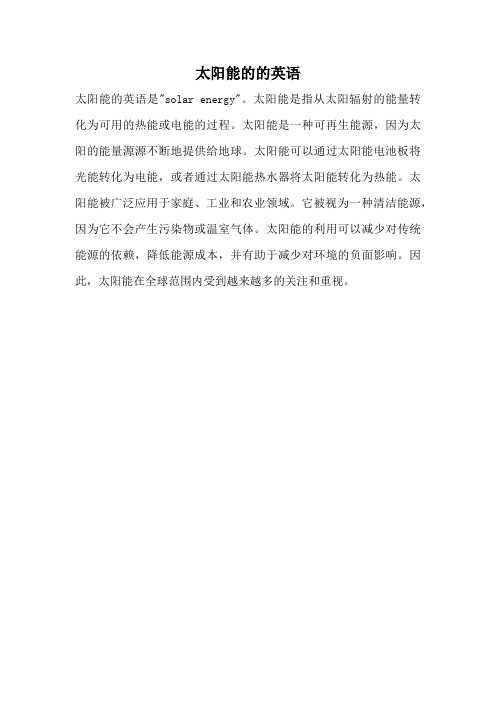
太阳能的的英语
太阳能的英语是"solar energy"。
太阳能是指从太阳辐射的能量转化为可用的热能或电能的过程。
太阳能是一种可再生能源,因为太阳的能量源源不断地提供给地球。
太阳能可以通过太阳能电池板将光能转化为电能,或者通过太阳能热水器将太阳能转化为热能。
太阳能被广泛应用于家庭、工业和农业领域。
它被视为一种清洁能源,因为它不会产生污染物或温室气体。
太阳能的利用可以减少对传统能源的依赖,降低能源成本,并有助于减少对环境的负面影响。
因此,太阳能在全球范围内受到越来越多的关注和重视。
- 1、下载文档前请自行甄别文档内容的完整性,平台不提供额外的编辑、内容补充、找答案等附加服务。
- 2、"仅部分预览"的文档,不可在线预览部分如存在完整性等问题,可反馈申请退款(可完整预览的文档不适用该条件!)。
- 3、如文档侵犯您的权益,请联系客服反馈,我们会尽快为您处理(人工客服工作时间:9:00-18:30)。
• Inside the sun by "hydrogen" fusing into "helium" nuclear reactions, kept releases enormous amounts of energy 内部氢原子发生聚变释放出巨大核能
As a new energy, solar energy has three characteristics compared to conventional energy sources: 1)the enormous amount
• Theoretically speaking, the solar battery conversion efficiency can almost 100%. However, due to current this research is still in the cradle. • Solution of solar cell formation in very low concentrations, its conversion efficiency is very low ,also along with the further perfecting experiment, conversion efficiency will keep growing.
But there are many limitations of using solar energy
• (1) dispersion (low energy density) • (2) Instability • (3) Low efficiency and high cost.
太阳能
How can we make full use of solar energy?
• Organic solar cell theory conversion efficiency almost 100% Researchers in the United States use extracted from plants the proteins and phosphate chemical compounds such as carbon nanotubes ,Developed can simulate plant photosynthesis mechanism of self-assembling solar cells. New batteries are still has good self-healing capability. In this way, the solar cells photoelectric conversion efficiency reached 40%
Today, we have already adopted a
variety of different ways of developing its use, it has become necessary for our daily part of life and has greatly changed our lives. Here is our common examples of solar energy.
there are solar house, solar cookers, solar greenhouse, solar drying systems, solar technology, in particular, these technologies used widely in the north and west, with remarkable results.
Solar energy
• 主讲:chenyu(2010180109)Solar energy
1. how does solar energy generate ?
2. what are the solar energy?
advantages
of
3. how can we make full use of solar energy? 4. The future solar energy
Wide range of applications of solar
Solar car
太阳能
Solar power station
For example, unmanned weather stations, communication stations, television relay stations, sun clock, power rails, black light, beacon lights, railway signals
California Thermal Power Plant
Space solar power station
Solar Lawn Light Solar light Solar garden light
Solar Car
Solar Aircraft
The future solar energy
•Thank you!
Solar oven
太阳能 2) geographical universality
• there is no transport problems, particularly in rural , remote areas.
太阳能 3) non-polluting
Solar energy is a clean source of energy,will not cause pollution.
• Solar electrical energy generation : Solar power conversion efficiency low (11%), cost is high. Solar thermal power generating cost is the 5 ~ 10 times higher than Coal-fired power • At present main use of solar panels is purity silicon. To 99.9999%
